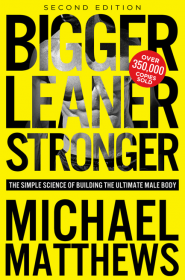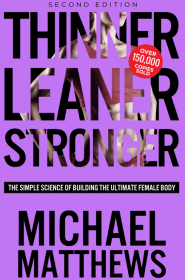How Long Should You Rest Between Sets to Gain Muscle and Strength?
If you want to know what science says about how long you should rest between sets to gain muscle and strength, then you want to read this article.
Key Takeaways
- Researchers wanted to see how resting one minute between sets or three minutes between sets affected strength, muscle growth, and muscular endurance.
- The group that rested three minutes between sets gained more muscle, strength, and endurance and was able to do more volume after eight weeks of training.
- If you want to gain muscle and strength as quickly as possible, then you want to rest at least three minutes between your heavy, compound exercises.
If you want to know what science says about how long you should rest between sets to gain muscle and strength, then you want to read this article.
Key Takeaways
- Researchers wanted to see how resting one minute between sets or three minutes between sets affected strength, muscle growth, and muscular endurance.
- The group that rested three minutes between sets gained more muscle, strength, and endurance and was able to do more volume after eight weeks of training.
- If you want to gain muscle and strength as quickly as possible, then you want to rest at least three minutes between your heavy, compound exercises.
How long should you rest between sets?
Ask that question of the all-knowing Google, and you’ll get this answer:
If you want to gain strength, rest three to five minutes between sets.
If you want to gain muscle, rest one to two minutes between sets.
This makes sense at first glance.
Strength training programs are all about lifting as much weight as possible on the big, compound exercises like the squat, deadlift, and bench and overhead press.
By resting longer between every set, you’ll be able to add more weight and get stronger faster.
Bodybuilding programs, on the other hand, are all about doing as many sets and reps as possible in the time you have available to train.
By resting less between every set, you’ll be able to cram more sets and reps into your workouts and, theoretically, build more muscle.
Some people also claim that shorter rest periods are not only more time efficient than longer rest periods, they also directly stimulate muscle growth.
Is any of this true, though?
That’s what a team of scientists from CUNY Lehman College wanted to find out in a study published in 2016.
Let’s see what they did.
What Did the Researchers Do?
The researchers separated 23 18-to-35 year old male college students into two groups:
- A group that rested one minute between sets.
- A group that rested three minutes between sets.
The researchers divided the subjects into these groups based on their back squat one-rep max to ensure that both groups were more or less equally strong.
Both groups followed the same workout routine for eight weeks, which consisted of …
Specifically, here are the exercises they did:
- Bench press
- Military press
- Back squat
- Leg-press
- Leg extensions
- Wide-grip lat pulldown
- Seated cable row
All of the subjects had been lifting for at least six months and could squat their body weight or more. Reasonably strong, but not setting any records.
Everyone took every set to failure and added as much weight as they could every week while staying within the 8-to-12-rep range.
To track the subject’s progress, the researchers measured several different variables before and after the study:
- Muscle growth, by measuring the thickness of the biceps, triceps, and quadriceps with ultrasound imaging.
- Strength, by having everyone test their 1RM on the back squat and bench press.
- Endurance, by having everyone do as many reps as they could before failing with 50% of their 1RM.
The researchers also tracked the total volume performed by both groups by multiplying weight x reps x sets.
The participants were told to maintain their normal eating habits and refrain from taking any workout supplements aside from a post-workout whey protein shake on their training days.
Use this workout and flexible dieting program to lose up to 10 pounds of fat and build muscle in just 30 days…without starving yourself or living in the gym.
What Were the Study Results?
The group that rested three minutes between sets gained substantially more muscle, strength and endurance than the group that rested one minute between sets.
Both groups made gains, but the group that rested three minutes outmatched the group that rested one minute on every measurement.
Here’s how the two groups compared:
Elbow Flexor Thickness
3-Minute Rest Group: +5.1%
1-Minute Rest Group: +2.7%
Triceps Brachii Thickness
3-Minute Rest Group: +24%
1-Minute Rest Group: +0.04%
Anterior Quad Thickness
3-Minute Rest Group: +11.7%
1-Minute Rest Group: +6.4%
Vastus Lateralis Thickness
3-Minute Rest Group: +10.3%
1-Minute Rest Group: +9.1%
The three-minute rest group also got significantly stronger than the one-minute rest group.
Here’s how they compared:
Barbell Bench Press 1RM
3-Minute Rest Group: +11.2%
1-Minute Rest Group: +3.9%
Barbell Back Squat 1RM
3-Minute Rest Group: +13.2%
1-Minute Rest Group: +7%
The three-minute rest group also improved the number of reps they could bench press with 50% of their 1RM significantly more than the one-minute rest group, too:
Number of Reps with 50% of Bench Press 1RM
3-Minute Rest Group: +19%
1-Minute Rest Group: +11.5%
Finally, the three-minute group was also able to do significantly more total training volume (measured in total pounds lifted) during the eight weeks of the study.
Here’s how they compared:
Training Volume (Total Pounds Lifted
3-Minute Rest Group: 119,647
1-Minute Rest Group: 98,461
This works out to the three-minute group doing about 20% more training volume than the one-minute group. As long as you’re training at a sufficient intensity, more training volume results in more muscle growth, and that’s exactly what this study found.
Now, technically the difference in training volume between groups didn’t reach statistical significance, but it probably would have been if the study had used more subjects or lasted longer.
All in all, the group that rested three minutes between sets clobbered the group that rested one minute between sets on every level.
What Does This Mean for You?

If you want to gain muscle and strength as quickly as possible, then you want to rest at least three minutes between sets of heavy, compound exercises.
The main takeaway of this study was that resting more between sets trumped resting less between sets for muscle growth, strength gain, and muscular endurance.
Although this was just one study, a review study published in the journal Sports Medicine by two of this study’s authors concluded the same thing:
If you want to get big and strong as fast as possible, rest more between sets, not less.
At this point you may be thinking, “I barely have time to work out as it is, how am I supposed to make more time to rest between sets?”
Here’s the solution:
Do fewer sets and exercises, use heavier weights, and use the extra time to rest longer between sets.
You don’t necessarily have to rest exactly three minutes between every set to get bigger and stronger, but you should generally rest as long as you need in order to give your best effort on every set.
This may sound counterintuitive at first, but this “quality over quantity” approach is not only well-supported scientifically, it’s also helped thousands of people gain strength and muscle as fast as possible.
Ready to give this kind of training a shot? Check out this article to learn exactly how to put together a workout routine for gaining strength and muscle:
If you liked this article, please share it on Facebook, Twitter, or wherever you like to hang out online!
What’s your take on resting between sets? Have anything else to share? Let me know in the comments below!
Armistead Legge is the Editor-in-Chief for Muscle for Life and Legion Athletics. He has completed over 100 triathlons and cross-country, cycling, and adventure races, and has researched and written for over a dozen organizations, including the National Institutes of Health. When he isn’t helping people get into the best shape of their lives, he’s lifting weights, riding his bike, hiking, camping, reading, and making delicious food.
If you want a “paint-by-numbers,” step-by-step blueprint for building a muscular, lean, strong body…faster than you ever thought possible…then you want to check out my bestselling books.
Here’s a little sneak peek of what you’ll learn inside…
- The 7 biggest muscle building myths & mistakes that keep guys small, weak, and frustrated. (These BS lies are pushed by all the big magazines and even by many trainers.)
- How to build meal plans that allow you to build muscle, lose fat, and get healthy with ease…eating foods you love (yes, including those deemed “unclean” by certain “gurus”)…and never feeling starved, deprived, or like you’re “on a diet.”
- The 5 biggest fat loss myths & mistakes that keep women overweight, disappointed, and confused. (These BS lies are pushed by all the big magazines and even by many trainers.)
- An all-in-one training system that delivers MAXIMUM results for your efforts…spending no more than 3 to 6 hours in the gym every week…doing workouts that energize you, not wipe you out.
- A no-BS guide to supplements that will save you hundreds if not THOUSANDS of dollars each year that you would’ve wasted on products that are nothing more than bunk science and marketing hype.
- And a whole lot more!
The bottom line is you CAN achieve that “Hollywood body” without having your life revolve around it. No long hours in the gym, no starving yourself, and no grueling cardio that turns your stomach.
My book will show you how. Get it today and let’s build a body you can be proud of.

































